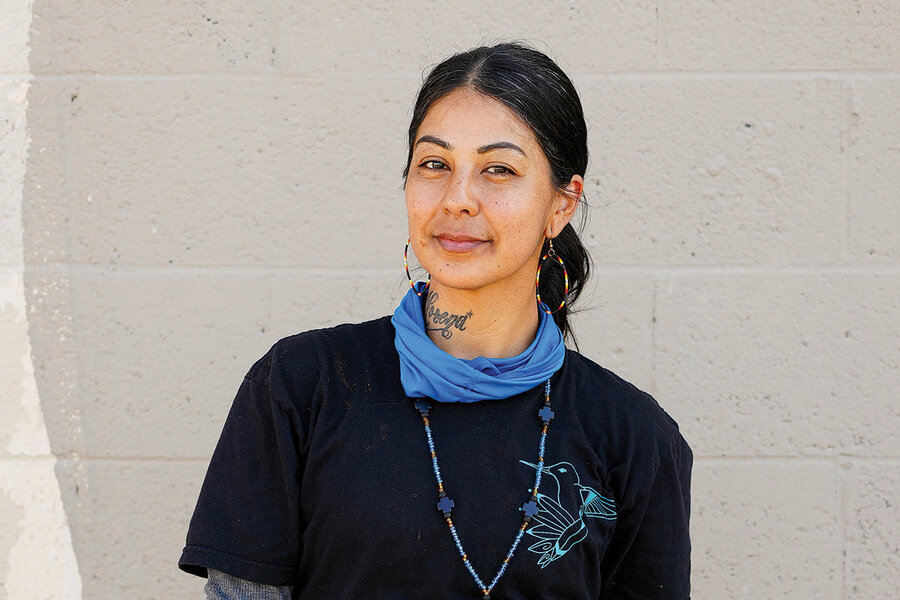
1. United States
The Super Bowl chose to feature an Indigenous artist for the first time. Born and raised in Phoenix, Lucinda Hinojos is Mexican American and Pascua Yaqui, Chiricahua Apache, White Mountain Apache, and Pima.
Her painting celebrating the event depicts the Vince Lombardi Trophy surrounded by cactuses and hummingbirds, a field of corn, and the White Tank Mountains in the background. The design was used on game tickets and promotional materials.
Why We Wrote This
In our progress roundup, problem-solving includes a nonprofit harnessing animals’ sense of smell to sniff out land mines, shipping companies turning to wind energy, and Bolivians cooperating to protect their source of water, upstream and down.
The NFL’s all-female arts team offered direction but gave Ms. Hinojos creative flexibility. “A lot of people try to put us in a box and stereotype us – that we look this way or we paint this way,” she said. “But with this painting, I combined both my cultures, the Chicano and Native cultures, and I did that with the colors that I used.” Ms. Hinojos also collaborated with other Indigenous artists like Anitra Molina, Carrie Curley, and Eunique Yazzie to create a 9,500-square-foot mural on the Monarch Theatre in downtown Phoenix. And Navajo artist Randy Barton created designs for the interior of the football stadium in Glendale, Arizona.
Sources: ICT News, The Art Insider
2. Bolivia
Bolivia’s city dwellers and rural farmers are cooperating to protect watersheds. What happens upstream affects those downstream. Through reciprocal water agreements, municipalities and fees from urban residents’ water bills contribute to farmers caring for forests and important water sources. These farmers are connected with clean water or other agricultural resources in return. According to the Natura Foundation, which spearheaded the efforts in 2003 and helps fund them, there are now some 24,000 farmers in Bolivia protecting over 500,000 hectares (1.2 million acres) of land in dozens of municipalities, benefiting over 18,000 families. The program is being emulated in Colombia, Peru, Ecuador, and Mexico.
The strategy is related to the idea of payment for ecosystem services (PES), which has been used in realms from biodiversity conservation to carbon sequestration. PES has also been criticized for promoting the monetization of nature rather than conservation for its own sake. But for participants in Bolivia, the agreement offers peace of mind. “We are all aware that our boliviano is going up there, straight to the water sources,” says Renán Seas, vice president of a water service cooperative. “Otherwise our water supply, which is vital for life, is going to be affected.”
Source: Mongabay
3. Belgium
Rats trained by a Belgian organization are sniffing out land mines. Land mines emit an odor undetectable to humans but easily discerned by the African giant pouched rat. Nonprofit organization Apopo has spent 25 years perfecting the training for its “HeroRATs” to detect explosives buried up to 20 centimeters (8 inches) in the ground. Some 300 rats have taken part in a nine-month certification program and are now detecting land mines in Cambodia, Angola, Mozambique, and Zimbabwe.
The rats are bred and raised in constant contact with people, making them easy to train and handle. Unlike metal detectors, the creatures know to ignore scrap metal. And while a metal detector could take four days to demine an area the size of a tennis court, trained rats can tackle the job in half an hour. They learn faster, require less food than dogs, and are easier to transport. Rats are not heavy enough to activate most land mines, so no Apopo rats have been injured or killed through their detection work. Apopo rats also detect tuberculosis and are being trained in simulated disaster zones to help find survivors.
Sources: Good, Apopo
4. Holy Land
The first female pastor was ordained in the Holy Land. The Rev. Sally Azar, a Palestinian, will lead the English-speaking Lutheran congregation in Jerusalem and in Beit Sahour, West Bank. Ms. Azar joins four other female pastors ordained in the Middle East – one in Syria and three in Lebanon.
As of 2017, around 47,000 Christians lived in the occupied West Bank and the Gaza Strip. Many are part of the Greek Orthodox and Latin Catholic churches, where women cannot serve as priests. Ms. Azar says she knows it will take time to normalize her role. “I hope that many girls and women will know this is possible and that other women in other churches will join us.”
Sources: BBC, Al Jazeera
World
More cargo ships are harnessing the wind to reduce use of fossil fuels. Shipping generates nearly 3% of the world’s greenhouse gas emissions – more than emitted by the country of Germany. Companies are developing new technologies to take advantage of abundant wind power.
French company Airseas offers a massive kite that attaches to ships and flies above the ocean to lower fuel consumption by an average of 20%. Sweden’s AlfaWall Oceanbird boasts upright wing rigs with a flap to take advantage of aerodynamics and function similar to airplane wings.
The innovations offer an unexpected benefit: quiet. “You see dolphins swimming alongside you because they’re not afraid of the engine,” said Jeremy Starn of Sailcargo, a Costa Rica-based clean-shipping company. “It’s a really humbling experience to be connected so closely to nature.”
Source: The Washington Post


